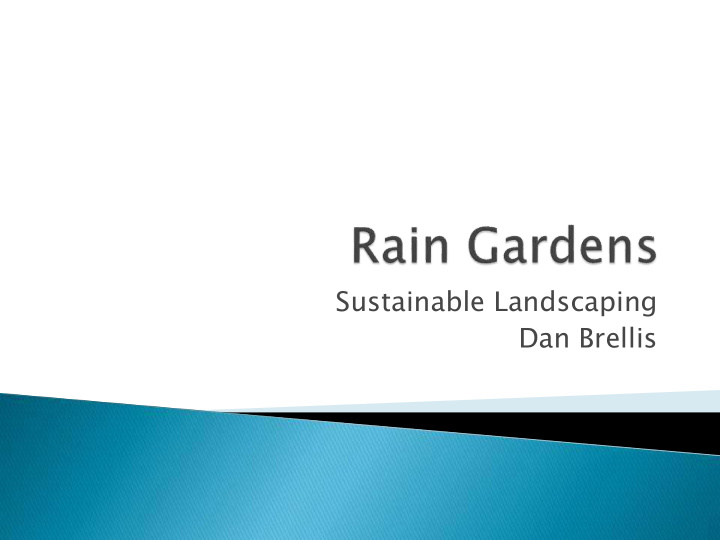



Sustainable Landscaping Dan Brellis
Alliance for the Chesapeake Bay Chesapeake Conservation Landscaping Council allianceforthebay.org chesapeakelandscape.org
http://vimeo.com/23640933
Fertilizing is not necessary Tolerant of local climate and water conditions Attract wildlife Deep root systems Iris versacolor
Illustration from http://marc.org/
Planted depression Collects water runoff from roofs, driveways Allows water to absorb into soil Stormwater filtration and containment Rain garden ≠ pond
Hypericum densiflorum Plants Soils Cover
Plants Soils Cover Native Plants Wetland edge vegetation Sun, partial sun, shade Contribute to native wildlife Aesthetically pleasing Spiraea tomentosa
Plants Soils Cover Loose soils Offer filtration Allow easy root growth Amend soils if necessary ◦ 50-60% sand ◦ 20-30% topsoil (no clay) ◦ 20-30% compost
Plants Soils Cover Offers erosion control Traps moisture keeping soil moist Moderates soil temperature Gravel or Mulch Large stones for reinforcement during storms
Location Dimensions Plan for aesthetics Account for sunlight 10 – 30 feet down slope from ‘water source’
Location Dimensions Shape Drainage area Garden depth Garden area Width and length
Drainage Depth Area Encompasses all inputs of water ◦ Impervious surface area ◦ Ground level surface Calculate drainage area Roof Drainage Area (RDA) ◦ length x width x percentage ◦ RDA = 40’ x 60’ x 25% = 600 ft 2
Drainage Depth Area Slope implies depth Slope % = ( = (height/ ght/length) length) x 1 100 0 Determine slope Slope % = (9”/180”) x 100 Slope % = 0.05 x 100 ◦ Change in height Slope % = 5% ◦ Distance Increase depth per inch for cover layer More sloping sites, remove or add soil to level base Slope Depth m < 5% 5” deep 5% < m < 7% 6- 7” deep 7% < m < 12% ~8” deep
Drainage Depth Area
Drainage Depth Area Summarize previous calculations Determine ‘size factor’ Rain Garden Area = Drainage area x size factor
Drainage Depth Area
Safety with underground utilities Build and plant in late spring Capture runoff Outline rain garden shape Remove grass Construct berm if necessary Dig rain garden basin Amend soil mixture
Downspout extension Vegetated swale
Safety with underground utilities Build and plant in late spring Capture runoff Outline rain garden shape Remove grass Construct berm if necessary Dig rain garden basin Amend soil mixture
Help retain water on steep slope Low mound, top level with uphill side Use excavated soil from rain garden Vegetated or compacted and mulched
Safety with underground utilities Build and plant in late spring Capture runoff Outline rain garden shape Remove grass Construct berm if necessary Dig rain garden basin Amend soil mixture
Online Resources Cluster Well-established roots Bloom times Height, color, texture Sun, part sun, shade
Sample designs available online Overlap mature plants Compliment colors and textures Consider height
Layout plants while still in pots Plant from middle outward Dig holes to appropriate sizes Loosen roots before burying Label clusters Apply larger stones to reduce erosion Top with mulch or gravel
Maintenance is necessary until gardens become established Immediate watering Frequent watering Weeding Deadheading Lobelia cardinalis
http://www.aacounty.org/DPW/Highways/Rai nGarden.cfm (ITEM 5 has resources for installation) http://www.cwp.org/your-watershed- 101/what-you-can-do.html http://www.dnr.state.wi.us/runoff/rg/ http://www.nativeplantcenter.net/
Recommend
More recommend